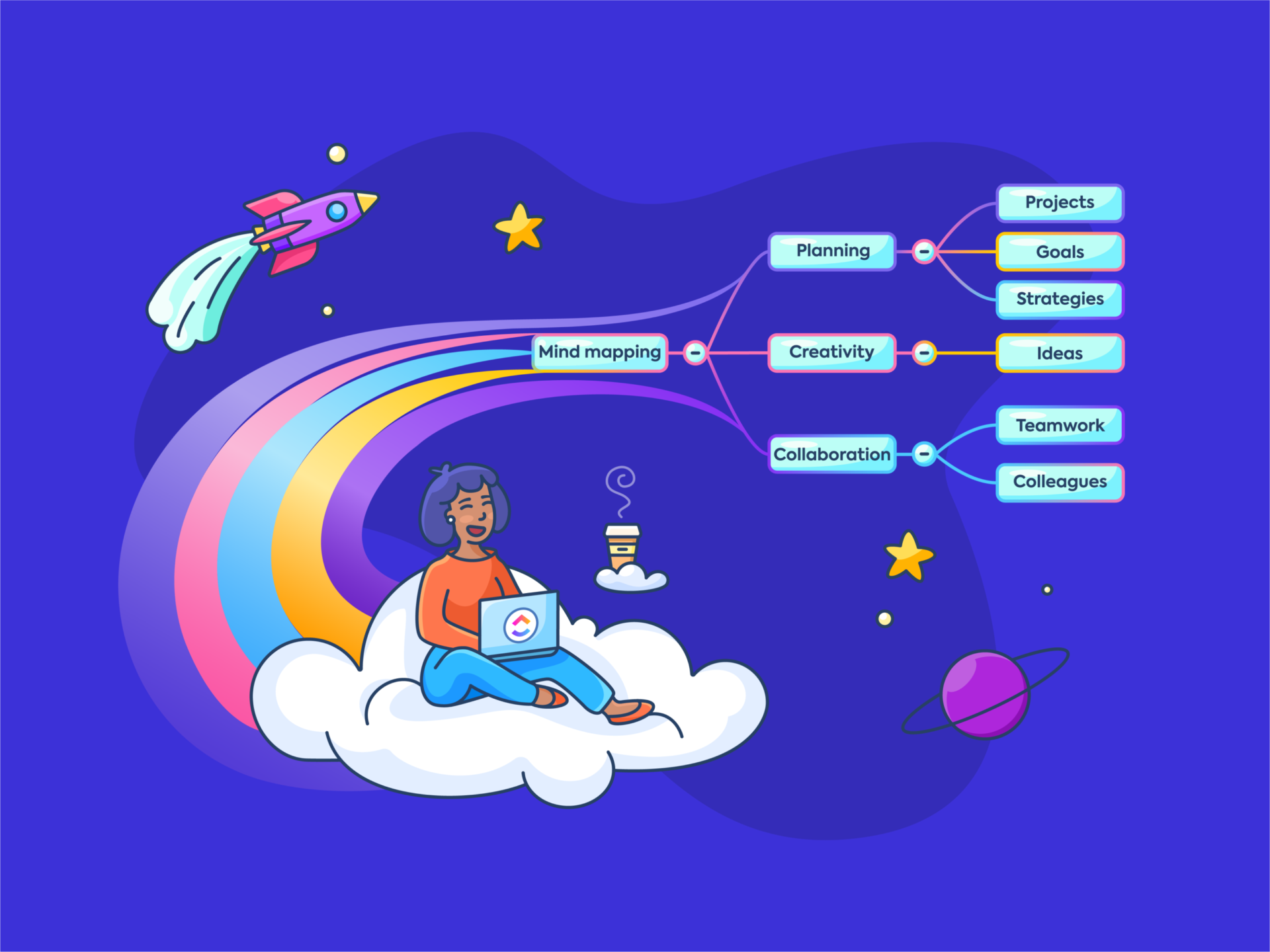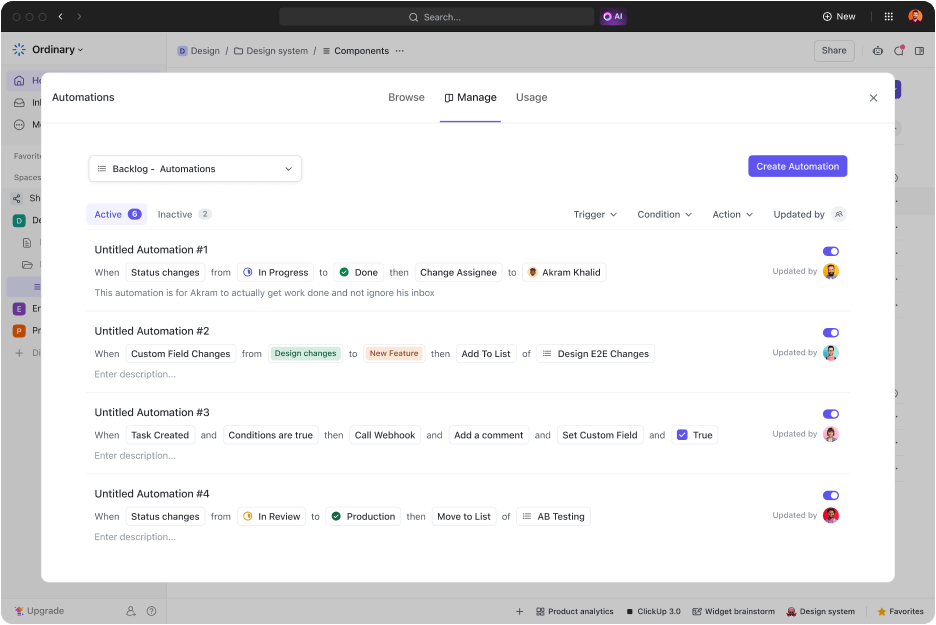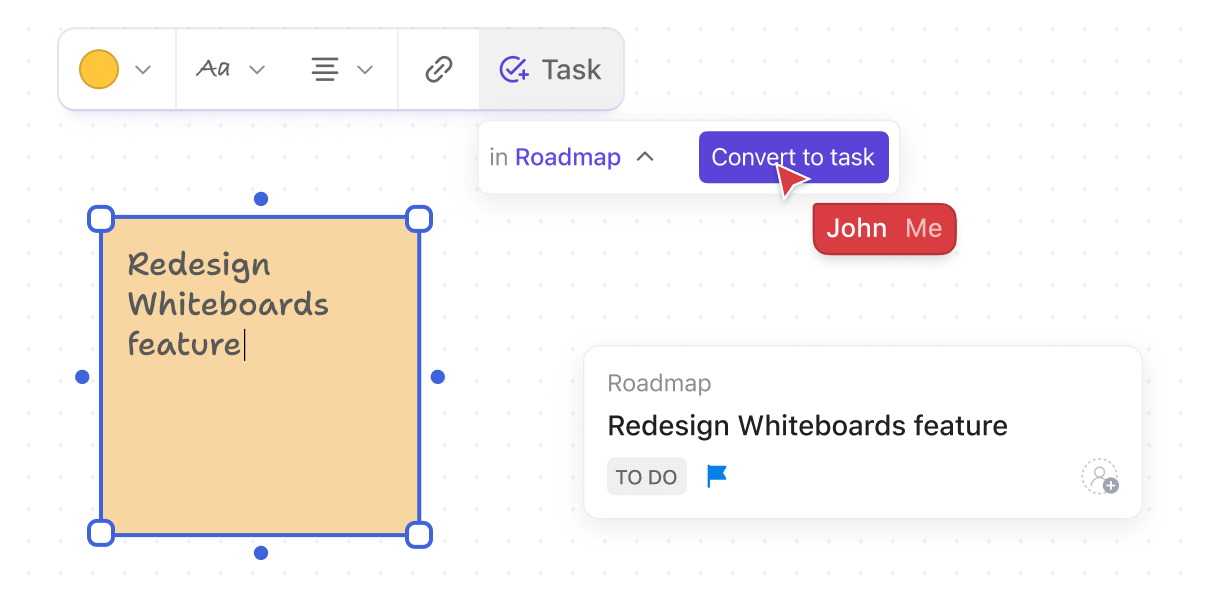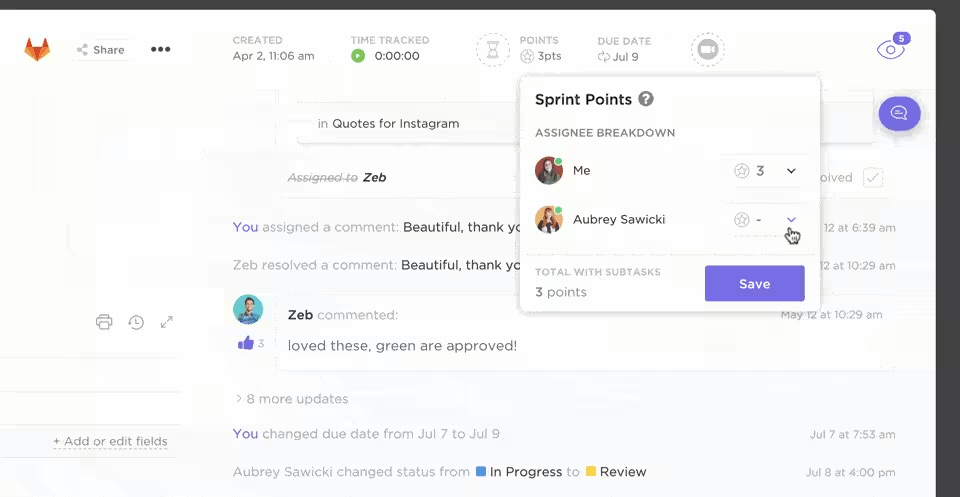How to Master a Productive Mindset and Achieve More

Sorry, there were no results found for “”
Sorry, there were no results found for “”
Sorry, there were no results found for “”
You began the day determined to conquer your to-do list, but as the evening rolled around, relentless interruptions left you with a scattered pile of half-finished tasks.
Maybe TikTok had hilarious cat videos, your kid or pet needed an extra dose of cuddles today, the weather played spoilsport, or your motivation simply went for a toss!
In these cases, how do you accomplish everything you set out to?
By developing a productive mindset.
In this blog post, we’ll explore actionable strategies to build a productive outlook and tackle challenges head-on to transform how you work.
A productive mindset is a focused and purposeful mental framework that empowers you to tackle tasks with clarity, determination, and efficiency. It’s about working smart, managing your energy, and prioritizing what truly matters.
Individuals with this mindset have a vision, think critically, and stay motivated. They don’t just complete tasks—they solve problems, adapt to change, and continually seek self-improvement by working smarter, not harder.
At its core, a productive mindset involves a balance of discipline and flexibility. You stay consistent in pursuing your goals while being open to change when necessary. This balance prevents burnout and helps you remain focused on your long-term vision.
And when you combine this mindset with a state of ‘flow’ (where productivity and contentment merge), you become unstoppable. The key is to channel your energy into meaningful work and organize your resources to stay aligned with your goals.
🔍 Did You Know? Walter Gjergja, a secular Shaolin monk, emphasizes that action is key to overcoming procrastination. He advocates for micro-commitments and personal rituals to build momentum and productivity.
Mindset is your mental map, shaping how you perceive challenges, opportunities, and decisions. It influences every action you take, whether it’s staying consistent or embracing a new perspective.
Motivation, on the other hand, is the fuel that powers you through these actions, providing the energy to move forward.
Together, mindset and motivation create a synergy that drives success. Balancing these two is essential for both professionals and self-improvers. A clear mental map combined with consistent energy ensures you’re not just busy but truly hitting your productivity goals.
Without the right mindset, motivation can lack direction; without motivation, even the best mindset won’t lead to action.
📌 Example: A growth-oriented mindset helps you view setbacks as opportunities for learning, while strong motivation gives you the perseverance to overcome obstacles.
👀 Did You Know? According to a poll of 143 creativity researchers published in Carol Dweck’s bestselling book, Mindset, perseverance or resilience produced by the growth mindset was the top ingredient in creative achievement.
A productive mindset catalyzes both personal and professional growth. It shapes how you approach challenges, manage time, and achieve goals. Here’s how adopting this productivity plan can transform your life:
📖 Also Read: Best Books on Focus to Improve Your Concentration
A productive way of thinking means approaching tasks with clarity, intent, and purpose. Professional and self-improvers often exhibit distinct traits that set them apart. Here’s a closer look at some qualities of productive people and how they translate into real-world success:
Discipline forms the backbone of a productive mindset.
Successful people like Tesla’s founder and entrepreneur, Elon Musk epitomize this through time-blocking techniques, allocating specific minutes of the day to each task, and ensuring every moment counts.
This structured approach enhances focus and minimizes decision fatigue while allowing for the prioritization of high-impact work.
Productive individuals maintain a laser focus on their objectives by setting clear, actionable goals and outlining precise steps to achieve them.
Satya Nadella, CEO of Microsoft, exemplifies this approach by fostering a growth mindset within his organization, promoting continuous learning, and encouraging adaptability in pursuit of evolving goals. This growth-oriented mindset is fueled by curiosity, as productive individuals are always eager to explore new knowledge and gain fresh insights.
💡 Pro Tip: Transform your daily goals into SMART goals—specific, measurable, achievable, relevant, and time-bound—to stay motivated and maintain momentum. This structured approach provides clarity and helps you track progress effectively.
Flexibility is key to overcoming challenges and embracing change. Productive people adjust plans swiftly while staying aligned with their goals.
Jeff Bezos, the founder of Amazon, exemplifies adaptability by consistently leading the company into new areas, such as cloud computing and streaming media, even when these ventures faced initial skepticism.
His willingness to pivot and embrace change has been instrumental in transforming Amazon into a diversified technology giant, demonstrating how effective leaders can thrive in dynamic environments while remaining open to new ideas and strategies.
Maintaining focus amidst distractions is a powerful skill. It involves cutting out interruptions and designing an environment that encourages deep, concentrated work.
Leaders like Bill Gates famously dedicate ‘think weeks’ for undisturbed brainstorming and strategy development, highlighting the importance of concentration.
This dedicated time away from the daily hustle allows him to concentrate deeply on long-term visions and innovative ideas, demonstrating how intentional focus can lead to significant breakthroughs in leadership and business strategy.
💡 Pro Tip: Silence notifications, set clear boundaries during work hours, and prioritize tasks to ensure sustained concentration on meaningful goals.
A proactive attitude distinguishes productive individuals. Instead of waiting for tasks or challenges to arise, they anticipate needs and take the lead. This forward-thinking approach prevents bottlenecks and ensures steady progress.
💡 Pro Tip: Dedicate 15 minutes daily to assess upcoming tasks and potential roadblocks.
Well-structured planning is non-negotiable for productivity. Setting clear priorities helps professionals stay on top of what’s most important.
Warren Buffett’s 5/25 rule—focusing on the top five priorities and ignoring the rest—highlights the importance of narrowing your focus.
Cultivating a productive mindset is a gradual, step-by-step journey. Although it doesn’t transform you overnight, it’s certainly achievable with consistent effort and effective productivity hacks.
ClickUp, the everything app for work, helps you stay organized by bringing tasks, projects, and collaboration tools together in one place. Its task management, time tracking, and goal-setting features create the right environment to fit productivity into your daily routine.
Let’s explore how to be more productive and nurture this mindset using ClickUp to support your journey.
You do not rise to the level of your goals. You fall to the level of your systems.
Productive individuals excel at aligning their daily tasks with their larger goals. To do this, you need to:
📌 Example:
Top-level goal: Create the Q3 content plan

Our productivity globally has increased significantly since we implemented ClickUp. We currently have over 50 users across 5 continents who are cross-collaborating on very detailed projects. This has allowed us to cut down the delivery time of projects quite a bit.
💡 Pro Tip: Use ClickUp’s Marc Andreessen Productivity Template to prioritize tasks, set and track goals, and analyze progress to stay focused and ensure productive use of time.
Consistency is key to building momentum. Start your day with MITs (most important tasks) and stick to a structure that supports your energy levels. Embrace the concept of ‘eating your frog’—tackling the most challenging or least appealing task first thing in the morning; this boosts your confidence and sets a productive tone for the rest of the day.
Address these daunting tasks early to clear mental clutter and create space for more enjoyable work.
📖 Also Read: Inspirational Productivity Quotes to Fuel Your Day
Plan your mornings with the ClickUp Personal Productivity Template and forget the chaos of scattered to-do lists. This template provides a streamlined system to help you:
Finding a method that fits your work style can drastically improve focus and efficiency. One time management technique for this is time-blocking. If you’re new to this, then the ClickUp Calendar View must become your go-to!
With its hour-by-hour breakdown, you can easily schedule tasks throughout your day, ensuring each task has dedicated time.

You can also try the Pomodoro Technique, which involves working in focused intervals of 25 minutes followed by a five-minute break. This method enhances concentration and helps combat distractions, creating a sense of urgency to complete tasks within a set timeframe.
To support this technique, ClickUp’s Time Tracking tools can be employed to set timers for tasks, manage work intervals, and track time seamlessly across devices, ensuring you stay on schedule and maintain productivity throughout your day.

📌 Example: Update time entries retroactively or track browser time using the ClickUp Chrome Extension, making it easy to maintain productivity and take regular breaks throughout the day.
Using ClickUp Automations, you can also set triggers and actions that automatically start or stop timers based on task status changes or other criteria.

A clutter-free environment promotes mental clarity and a positive attitude, making optimizing both your physical and digital workspace essential. While organizing your desk is crucial, your digital tools also significantly contribute to productivity.
ClickUp Whiteboards is just the right tool for brainstorming ideas collaboratively. Multiple team members can contribute in real time, adding comments, shapes, text, and even images to the board. This makes it easy to get everyone’s input during brainstorming sessions or project planning.

Embracing proactivity and reflection is essential for sustained productivity and avoiding wasting time.
Proactivity involves anticipating challenges and preparing solutions before they arise, allowing you to stay ahead and reduce stress. In contrast, reflection entails regularly assessing your progress, identifying areas for improvement, and learning from your experiences.
Together, these practices create a strong feedback loop that enhances effectiveness.

ClickUp Docs is a powerful tool to enhance proactivity and reflection in your productivity journey. With its ability to maintain a digital journal, users can easily capture insights and document their thoughts, facilitating regular progress assessments. The collaborative features—inline commenting, simultaneous editing, @mentions, and more—allow teams to share reflections and strategies in real time, fostering a culture of continuous improvement.
Additionally, integrating Docs with ClickUp Tasks links reflections directly to specific projects, ensuring that lessons learned are applied proactively to future challenges while promoting accountability and growth.
ClickUp has made the productivity experience so much easier by having everything in one place. It has everything from Goals to Docs to keep your team and clients informed at all points of your process.
🧠 Fun Fact: Research indicates that self-discipline is a more accurate predictor of academic success than IQ, highlighting the importance of personal accountability in productivity.
In today’s hustle and bustle, maintaining focus has become increasingly challenging due to constant distractions from technology and our environment. Cultivating focus involves creating a dedicated workspace, minimizing interruptions, and establishing clear task priorities.

An effective solution to enhance focus is ClickUp Brain, an integrated AI assistant which is capable of distilling insights from all your information—about your tasks, docs, and people–in one place. This tool allows you to organize thoughts, tasks, and projects seamlessly, reducing the clutter that often leads to distraction. Use it to identify your priorities, create game plans for tackling complex projects, and monitoring your productivity.
ClickUp Brain also acts as an AI project manager that automatically updates project statuses, generates summaries of communications, and creates subtasks based on task details. This reduces the need for manual updates, eliminates unnecessary meetings, and minimizes time spent on busy work, allowing you to focus on more critical tasks.
With ClickUp, you can also centralize all your notes, tasks, and project details in one place to minimize search time. Create dedicated workspaces for specific projects, perform regular brain dumps to clear your mind, and schedule uninterrupted deep work sessions marked as ‘do not disturb.’
Finally, you can use your Brain as a sparring partner to reflect on your productivity at the end of the day, identify distractions, and adjust your strategies for continuous improvement.
💡 Pro Tip: Use a productivity template to streamline your workflow and optimize your time management by organizing tasks, deadlines, and priorities in one central hub. With pre-built structures for recurring processes, you can focus on execution instead of setup, ensuring every minute counts.
The Using ClickUp for Productivity Template is designed to help you manage tasks, balance workloads, and track your goals across short-, medium-, and long-term timelines.
Balancing multiple responsibilities can feel overwhelming, but this template helps you prioritize your most important tasks, ensuring that nothing is forgotten. It offers a clear structure for organizing tasks, so you can focus on what matters most. With built-in goal-setting and deadlines, it helps you stay on track and maintain direction throughout the day.
Using this template can simplify your workflow and reduce stress. It’s a great tool for clarifying your daily activities, and helping you allocate time and resources more efficiently.
ClickUp helps keep me organized and increases my productivity at work. I now get more done in less time since I’m more focused.
Balancing work and life is essential for sustaining productivity. When you’re overworked, burnout sneaks in, reducing focus and damaging your mental and physical health.
A recent report from Mercer reveals that 82% of employees are at risk for burnout, with contributing factors including excessive workload (37%), exhaustion (40%), and financial strain (43%).
A balanced approach ensures you stay energized, motivated, and fully present in both personal and professional settings.
To achieve this balance, set boundaries for work hours and block time for hobbies, exercise, or family.
You must also take a moment at the end of each week to assess what worked, what didn’t, and how you can improve. Ask yourself:
Actively manage your schedule by setting clear boundaries to avoid burnout, which will help improve productivity and allow you to approach your tasks with renewed focus and enthusiasm.
Work-life balance involves integrating breaks and leisure into your daily routine to recharge and refocus beyond merely setting boundaries.
Balancing responsibilities helps prevent burnout, while intentional rest enhances creativity, fosters a positive attitude, and bolsters motivation.
Initiate this approach with regular breaks in your schedule: dedicate 25–50 minutes to focus work on one task, then take short breaks to stretch or enjoy a coffee. These pauses refresh your mind with renewed energy and open the door to a different idea or perspective.
Plan focus sprints using ClickUp Sprints. Create dedicated sprint boards, set clear goals, prioritize tasks in the sprint backlog, and assign sprint points to estimate effort to reflect progress within your workflow.

Breaks are essential for maintaining peak performance. Integrate them into your routine to boost productivity and stay refreshed.
A Slack survey found that employees who take breaks are 13% more productive than those who do not. Additionally, employees who leave work on time are 20% more productive than those who stay late.
To track progress and ensure consistent momentum, the ClickUp Weekly Progress Template can help you review achievements, adjust priorities, and stay aligned with your goals each week.
Staying productive often means tackling common obstacles head-on. Here’s how you can address them effectively with ClickUp:
Procrastination often stems from feeling overwhelmed by too many tasks at once. Break this cycle with the ClickUp Personal Habit Tracker Template to establish a consistent routine, track daily work habits, and maintain a clear sense of direction.
Additionally, use ClickUp Task Priorities to create a structured action plan. This approach helps you see progress quickly, which keeps you motivated.
Motivation wanes when progress feels invisible. To combat this, make use of ClickUp Goals to visualize achievements by setting measurable objectives and tracking key results.
This visibility makes progress rewarding, helping maintain momentum and fostering a productive mindset among highly productive people. Celebrate these milestones to maintain momentum and foster a productive mindset, ensuring that motivation remains high as you navigate your tasks.
Taking on too much dilutes focus and energy. Address this challenge using ClickUp Automations to streamline your workload.
Automate repetitive tasks like status updates and task assignments, which helps you focus on more important tasks. This reduction in routine work allows you to take full responsibility for high-impact activities that drive results, boosting your overall effectiveness.
Frequent interruptions hinder deep focus, making it essential to create a distraction-free environment. ClickUp’s in-built focus mode helps by blocking non-essential notifications, allowing you to concentrate without distractions.
This feature enables you to filter out the noise from the outside world, ensuring that your workspace is optimized for concentration.
📖 Also Read: Work-Life Tips to Increase Your Productivity
With a structured plan, time stays put. Use the ClickUp Calendar View to adopt time-blocking techniques, scheduling dedicated periods for work, breaks, and personal activities to manage your time effectively.
💡 Pro Tip: Adopting the ‘Two-Minute Rule,’ popularized by David Allen, can boost productivity: if a task takes less than two minutes, do it immediately to prevent small tasks from accumulating.
A productive mindset enables you to work smarter, not harder, by focusing on clear goals, structured priorities, and efficient strategies. This way, you can combine focused effort with tools that make your workflow seamless.
ClickUp offers a range of powerful tools to help you stay organized and on track.
Using ClickUp Goals, you can visualize your progress and break down large projects into manageable milestones. Docs and templates make planning straightforward, allowing you to easily set up everything from project timelines to meeting agendas.
For those repetitive tasks, ClickUp Automations takes care of the busy work, saving you time and reducing errors. Additionally, ClickUp’s Time Tracking helps you stay focused and monitor how efficiently you use your time. ClickUp Brain also comes into play, offering an AI-driven way to manage your content ideas, research, and tasks in one place.
Why wait to be your most productive self? Sign up to ClickUp today!
© 2025 ClickUp